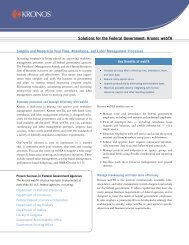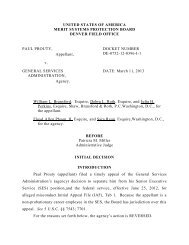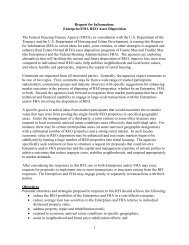Wastebook - Senator Tom Coburn - U.S. Senate
Wastebook - Senator Tom Coburn - U.S. Senate
Wastebook - Senator Tom Coburn - U.S. Senate
Create successful ePaper yourself
Turn your PDF publications into a flip-book with our unique Google optimized e-Paper software.
<strong>Wastebook</strong> 20137. Mass Destruction of Weapons – (DoD) $7 billionAs the U.S. war effort in the Middle East winds to a close, the military has destroyed more than 170million pounds worth of useable vehicles and other military equipment. 103 The total amount ofequipment eventually to be scrapped—the equivalent of 77,000 metric tons—is approximately 20percent of the total war material the U.S. military has in Afghanistan. 104,105The military has decided to simply destroy more than $7 billion worth of equipment rather than sell itor ship it back home. 106“We have a lot of stuff there. Inevitably, we overbought,” stated Gordon Adams, a professor atAmerican University and former defense official in the Clinton administration. “We always do whenwe go to war.” 107Why just not leave the excess equipment in country for use by the Afghan military? A major concern isthat Afghanistan’s forces would be unable to maintain it. Moreover, there is worry the defenseindustry might suffer if the Pentagon unloads tons of used equipment on the market at vastly reducedprices. 108 This should be viewed as market correction and a positive outcome of the drawdown, not areason to send valuable equipment to the scrap heap.The most controversial aspect of the disposal is the mass destruction of Mine-Resistant AmbushProtected (MRAP) vehicles—the massive beige personnel carriers the Pentagon raced to buildstarting in 2007 to counter the threat of roadside bombs in Iraq and Afghanistan. 109The Pentagon has determined it will no longer require about 12,300 of its 25,500 MRAPs. 110In Afghanistan alone, about 2,000 of roughly 11,000 MRAPs have been labeled excess by the military.About 9,000 will be shipped to the United States and U.S. military bases in Kuwait and elsewhere, butthousands of remaining vehicles, each worth at least $500,000, will simply be shredded. 111The MRAPs were once in hot demand, especially by members of Congress. In 2007, Congressappropriated $4 billion for the MRAP program, which was ten times more than the $400 millionrequested by the Pentagon. The vehicles were as difficult to manufacture as they were popular. The3/8 -inch steel on the vehicles is difficult to produce, and only a few contractors provide it. 112In 2007, the Department of Defense made the acquisition of MRAPs its highest priority. More than24,000 MRAPs were built for troops in Iraq and Afghanistan, costing taxpayers an estimated $45billion. 113Congress’ excess is now on display, however.What was once the Defense Department’s highest priority is now the Afghanistan scrap market’sflavor of the month. Much of the military’s equipment will continue to be shredded for pennies perpound on the Afghan scrap market. U.S.-made war scrap will likely be worth $80 million on theinternational market. 114The Army has roughly $25 billion worth of equipment in Afghanistan. Some military leaders simplywanted to bring most of it home, but they were overruled because the cost of shipping heavy14














